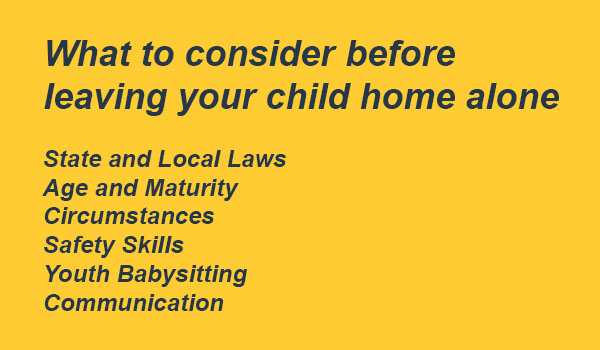This post was updated on 7-15-24 to include a link to the Child Welfare Information Gateway’s factsheet, which provides guidance on leaving your child home alone.
Please keep in mind that this is intended only to provide information, not to advise or provide any kind of guidance. If you need specific guidance on if you can leave your children home alone, contact your county social services or Tribal offices and ask to speak with someone who can inform you on your county/Tribal Specific guidelines.
Parents and caregivers of children are often faced with the question: in what situations, and for how long, can I leave my child home alone?
Like nearly every other state in the US, Minnesota does not have an explicit law pertaining to the specific age at which children can be left home alone. Illinois sets this age at 14, Maryland at 8, and Oregon at 10. However, DHS Child Maltreatment Screening Guidelines, which establish policy for county agencies, do provide specific criteria. For the most part though, cities, counties, and states tend to look at a variety of factors, including age, when determining whether a specific child can be left home alone, unsupervised.
A State-Supervised, County-Administered System Means County-Specific Policies
Minnesota has a state-supervised, county-administered child welfare system. The Minnesota legislature passes laws, the Governor of Minnesota signs them (or vetoes them), and the Minnesota Department of Human Services establishes general rules, policies, and guidelines based on these laws and best practices.
It is important to note that foster parents are advised to consider additional elements when it comes to leaving children in their care alone. According to a Child Welfare Information Gateway factsheet, “Federal law regarding foster care includes the reasonable and prudent parent standard, which allows foster parents greater discretion in making decisions regarding the daily activities of the children and youth in their care. For specific guidance, foster parents should consult with their caseworker, who can provide information tailored to the child or youth’s specific situation and the local regulations or guidelines.”
If Each County is Unique, How Do I Know When I Can Leave My Kid(s) Home Alone?
While Minnesota statute includes ‘lack of age-appropriate supervision’ as a form of neglect, it does not specify the age at which a child can be left unsupervised:
A parent, legal guardian, or caretaker who willfully deprives a child of necessary food, clothing, shelter, health care, or supervision appropriate to the child’s age, when the parent, guardian, or caretaker is reasonably able to make the necessary provisions and the deprivation harms or is likely to substantially harm the child’s physical, mental, or emotional health is guilty of neglect of a child and may be sentenced to imprisonment for not more than one year or to payment of a fine of not more than $3,000, or both. (Source: Minn. Stat. 609.378, Subd. 1 (a)(1))
Requirements and Factors to consider
 Page 60 of the DHS Child Maltreatment Screening Guidelines outlines specific requirements for when children can be left alone and for how long. County child protection agencies are required to follow these criteria in reviewing child protection reports. Agencies may look at additional factors in individual situations when considering the safety of a child being left alone. Although agencies cannot be less protective than the Screening Guidelines, there may be other factors that can impact decisions beyond those age factors and response path. For example, DHS guidelines state that whether they decide to investigate or assess a report concerning lack of supervision depends on a variety of factors, including the child’s age, maturity level, the child’s reaction to being left home alone or caring for other children, whether a responsible adult can be reached and if the child has the means to reach the adult (phone, phone number, etc.), and the kinds of activities in which the child is engaged (using a stove, for example). If you have questions related to age-appropriate supervision, contact your county social services or Tribal offices and ask to speak to child welfare services for guidance in making the right decision.
Page 60 of the DHS Child Maltreatment Screening Guidelines outlines specific requirements for when children can be left alone and for how long. County child protection agencies are required to follow these criteria in reviewing child protection reports. Agencies may look at additional factors in individual situations when considering the safety of a child being left alone. Although agencies cannot be less protective than the Screening Guidelines, there may be other factors that can impact decisions beyond those age factors and response path. For example, DHS guidelines state that whether they decide to investigate or assess a report concerning lack of supervision depends on a variety of factors, including the child’s age, maturity level, the child’s reaction to being left home alone or caring for other children, whether a responsible adult can be reached and if the child has the means to reach the adult (phone, phone number, etc.), and the kinds of activities in which the child is engaged (using a stove, for example). If you have questions related to age-appropriate supervision, contact your county social services or Tribal offices and ask to speak to child welfare services for guidance in making the right decision.
Guidelines from DHS (page 60-61) are cited below:
Reports alleging inadequate supervision or child care arrangements may be screened in for a child protection response, including children’s ages:
- 7 and under left alone for any period of time
- 8-10 left alone for more than three hours
- 11-13 left alone for more than 12 hours
- 14-15 left alone for more than 24 hours
- 16-17 may be left alone for more than 24 hours with a plan in place on how to respond to an emergency
Reports alleging inadequate child care arrangements may be screened in for a child protection response according to the following guidelines.
- Under age 11 should not provide child care
- Ages 11-15 placed in a child care role are subject to the same time restrictions of being left alone as listed above
- Ages 16-17 may be left alone for more than 24 hours with adequate adult back-up supervision. If children are left alone at the time a report is received by the local welfare agency, and the circumstances fall outside of timelines listed above, the local welfare agency may refer the matter to an appropriate law enforcement agency for an immediate child welfare and safety check.
Other Resources Available
Before you leave children alone, make sure to consult with your county agency. Also make use of the Healthy Children Checklist to gauge if your particular child is mature enough to be left alone. Consult The American Red Cross’s safety steps for parents to take before leaving. Finally, at the national level, the Child Welfare Information Gateway has a factsheet from 2023, which provides guidance on leaving your child home alone.
